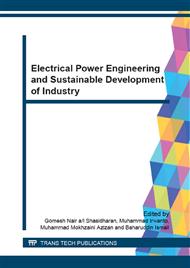[1]
U.S. Energy Information Administration, International Energy Outlook (2013).
Google Scholar
[2]
Dale Vince, The End of Fossil Fuels (2013).
Google Scholar
[3]
R. Bianchini, Leveraging renewable energy in data centers: present and future, Proc. High-Performance Parallel and Distributed Computer Int. ACM Symp., Delft, The Netherlands, Jun. 18–22, 2012, p.135–136.
DOI: 10.1145/2287076.2287101
Google Scholar
[4]
S. Kuoro, M. Malinowski, K. Gopakumar, J. Pou, L. G. Franquelo, B. Wu, J. Rodriguez, M. A. Perez, and J. I. Leon, Recent advances and industrial applications of multilevel converters, IEEE Transactions on Industrial Electronics, vol. 57, no. 8, p.2553–2580, Aug. (2010).
DOI: 10.1109/tie.2010.2049719
Google Scholar
[5]
A. Nordvall, Multilevel inverter topology survey, Master of Science Thesis in Power Electric Engineering, (2011).
Google Scholar
[6]
M. Sandhu and T. Thakur, Multilevel inverters: literature survey – topologies, control techniques & applications of renewable energy sources – grid integration, Int. Journal of Engineering Research and Applications, vol. 4, issue 3, p.644–652, Mar. (2014).
Google Scholar
[7]
J. Rodriguez, et al., Multilevel converters: an enabling technology for high power applications, Proceedings of the IEEE, vol. 97, no. 11, p.1786–1817, Nov. (2009).
Google Scholar
[8]
E. Ozdemir, S. Ozdemir, and L. M. Tolbert, Fundamental-frequency-modulated six-level diode-clamped multilevel inverter for three-phase stand-alone photovoltaic system, IEEE Trans. Ind. Electron., vol. 56, no. 11, p.4407–4415, (2009).
DOI: 10.1109/tie.2008.928096
Google Scholar
[9]
M. I. Desconzi, R. C. Beltrame, C. Rech, L. Schuch, and H. L. Hey, Photovoltaic stand-alone power generation system with multilevel inverter, Renewable Energies and Power Quality Int. Conf., Las Palmas, Spain, Apr. 13–14, (2010).
DOI: 10.24084/repqj09.479
Google Scholar
[10]
H. Patangia and D. Gregory, An efficient cascaded multilevel inverter suited for PV application, 35th IEEE Photovolt. Spec. Conf., Honolulu, HI, Jun. 20–25, 2010, p.2859–2863.
DOI: 10.1109/pvsc.2010.5615922
Google Scholar
[11]
R. M. Nakagomi, Y. Zhao, and B. Lehman, Multi-level converters for three-phase photovoltaic applications, 12th IEEE Control Model. Power Electron. Workshop, Boulder, CO, Jun. 28–30, 2010, p.1–6.
DOI: 10.1109/compel.2010.5562436
Google Scholar
[12]
A. Chitra and S. Himavathi, Modeling and experimental validation of solar PV system for cascade H-bridge multilevel inverter, Power, Energy and Control Int. Conf., Dindigul, India, Feb. 6–8, 2013, p.260–265.
DOI: 10.1109/icpec.2013.6527662
Google Scholar
[13]
F. L. Luo, Investigation on best switching angles to obtain lowest THD for multilevel DC/AC inverters, IEEE Conf. Industrial Electronics and Applications, (2013).
DOI: 10.1109/iciea.2013.6566663
Google Scholar


